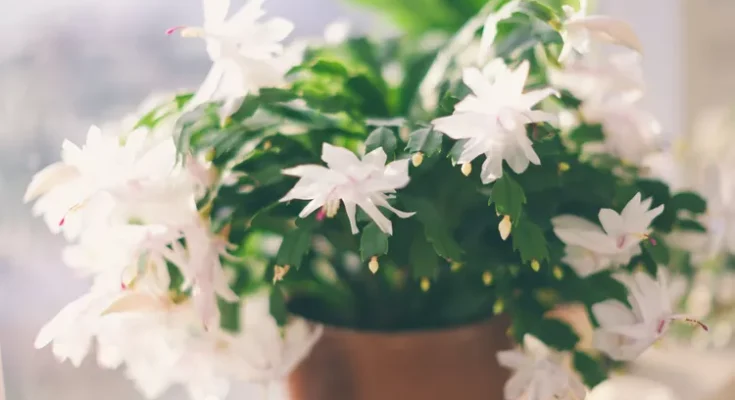Thanksgiving cactus is one of the most popular houseplants for holiday gift giving with exotic-looking flowers opening just in time for the festivities. Plants bloom from mid-November well into the New Year in shades of pink, rose, red, white, and yellow. Thanksgiving cactus is an easy to grow houseplant that, given the right conditions, can last a lifetime. Learn how to grow Thanksgiving cactus and encourage them to bloom for the holidays.
Identifying a Thanksgiving Cactus
Thanksgiving cacti (Schlumbergera truncata) are often confused with Christmas cacti (Schlumbergera x buckleyi), which they closely resemble. The two plants can be differentiated by looking at the flattened stem segments, called phylloclades. Note that there are no true leaves on either of these cacti. In the Thanksgiving cactus, the stem segments have pointed or hook-shaped projections along the edges. The Christmas cactus has more scalloped or step-like projects. Another difference between the two species is the color of the flower’s anthers, which are yellow in Thanksgiving cacti and purplish brown in Christmas cacti.
Thanksgiving cacti and Christmas cacti are collectively referred to as holiday cacti, along with the Easter cactus, with each species blooming around the holiday for which they are named. Because they are in bloom leading up to Christmas, Thanksgiving cacti are the most common species available in stores during the holiday season.
How To Grow and Care for a Thanksgiving Cactus
Thanksgiving cactus is native to the rainforests of Brazil. Although it is a true cactus, the plants do not grow under the conditions commonly associated with cacti. They are epiphytes, meaning they grow on other plants, such as in the crooks of tree branches. As houseplants, Thanksgiving cacti prefer a loose, well-draining growing medium. They do not tolerate heavy soils and require good aeration, which can be achieved by incorporating up to 40% perlite into a potting mix. Thanksgiving cacti do well when a little pot bound. Repot plants only every two to three years. Provide the following conditions for optimal growth:
- Light: Provide bright indirect light, such as in an east- or north-facing window. Plants perform well when brought outdoors for summer. Outdoors, locate your cactus in filtered sunlight, such as under a tree. Too much light can cause plants to appear pale or yellow. Light plays an important role in flower bud formation, which is discussed in detail below.
- Water: Water plants when the soil is dry to the touch. Thanksgiving cacti are sensitive to root rot. Avoid overwatering plants and do not let water sit in the saucer beneath containers. Plants can be allowed to dry out slightly during the spring and summer months, but consistent soil moisture is necessary during flowering.
- Temperature: Thanksgiving cacti thrive under normal household conditions, with daytime temperatures between 65°F – 70°F and cooler night temperatures falling to a minimum of 55°F – 65°F. Plants do not tolerate freezing temperatures or frost. Temperature also plays a role in flower bud formation, as discussed below.
- Nutrition: Fertilize plants monthly with a balanced fertilizer at half strength when plants are actively growing in spring through August. Limit nitrogen applications in autumn, at which time a low nitrogen fertilizer (for example 0-15-10) can be used to boost flower bud formation.
- Pruning: Pinch back stems in early June to promote branching, which will encourage more flowers come autumn. Some growers also pinch plants back in September to remove immature stem segments and create a more even crown. Immature stem segments (less than 1 cm) do not flower.
Getting a Thanksgiving Cactus To Bloom
Both light and temperature play a role in Thanksgiving cactus flower bud formation. Flowering is triggered by the shorter days and cooler nights of autumn. The ideal conditions for flower bud formation include bright daylight followed by fourteen hours of continued darkness in a cool environment with temperatures between 60°F and 68°F. Due to artificial lighting and the warmer temperatures typical of modern households, these can be challenging conditions to provide. However, Thanksgiving cactus may not bloom if temperatures remain too warm and/or plants do not receive the required amount of darkness.
What is a plant lover to do? If you have the space available, move your Thanksgiving cactus to a seldom-used room, heated garage window, or other location where lighting can be controlled. Do not expose the plants to artificial light after sunset for six weeks beginning in the middle of September. Once flower buds develop, plants can be moved back to their normal location for display, as day length has no effect on flowering after the buds are set. Maintain air temperatures in both locations between 60°F and 68°F for optimal bloom.
If you do not have a “dark room” try placing your Thanksgiving cactus in a cool window. Cool temperatures can sometimes override day-length requirements. Plants grown with cooler night temperatures, between 55°F and 65°F, will often set flower buds regardless of day length. Be careful not to expose plants to temperatures below 50ºF, which can cause bud drop.
A little experimentation will help you identify the ideal flowering conditions in your home so you can enjoy the festive blooms of your Thanksgiving cactus year after year.



